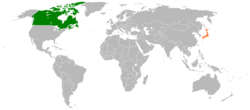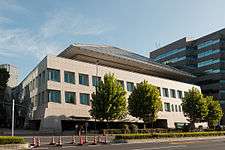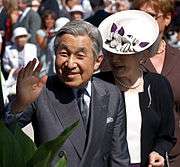Canada–Japan relations
 |
|
Canada |
Japan |
|---|---|
Canadian-Japanese relations is a phrase to describe the foreign relations between Canada and Japan. The two countries enjoy an amicable companionship in many areas. Diplomatic relations between both countries officially began in 1950 with the opening of the Japanese consulate in Ottawa. In 1929, Canada opened its Tokyo legation, the first in Asia;[1] and in that same year, Japan its Ottawa consulate to legation form.[2]
Created in 1929, the Canadian mission to Japan is Canada's oldest mission in Asia and third oldest non-Commonwealth mission after the United States and France. Canada has an embassy in Tokyo and a consulate in Nagoya. Japan has an embassy in Ottawa and four Consulates-General – in Calgary, Montreal, Toronto and Vancouver. Both countries are full members of G7, G8, OECD and APEC.
History

Early contacts
Some Canadian-Japanese contacts predate this mutual establishment of permanent legations. The first known Japanese immigrant to Canada, Manzo Nagano, landed in New Westminster, British Columbia in 1877.[3]
A number of Canadian missionaries working in Japan during the Meiji period played significant roles in both the development of local Japanese Christian churches as well as the modernization of Japan's educational system. Significant among this number were the Rev. Alexander Croft Shaw, a close associate of Yukichi Fukuzawa of Keio University, G.G. Cochran who helped found Doshisha University and, Davidson McDonald who helped in establish Aoyama Gakuin University.[2]
In 1887, the sailing route for steamships between Yokohama and Vancouver was opened,[3] with vessels in the ocean service of the Canadian Pacific Railway making regular voyages.[4] One of these Canadian ships, the RMS Empress of Australia and her captain, Samuel Robinson, RNR gained international acclaim because of rescue efforts undertaken after the Great Kanto Earthquake of 1923.[5]
From 1904-1905, Herbert Cyril Thacker of the Royal Canadian Field Artillery served in the field as a military attaché with the Japanese Army during the Russo-Japanese War.[6] He was awarded the Order of the Sacred Treasure, Third Class by the Japanese government for his services during the Russo-Japanese War.[7] He also received the Japanese War medal for service during that campaign.[6]
Japan was an ally of the British Empire during the First World War.
Opening of diplomatic missions
The legation Canada opened in Tokyo in 1929 was its third outside the Commonwealth following Washington and Paris. That fact highlights the exceptional importance Canada placed on Japan as a hub for its diplomatic activities throughout Asia.[2] However, the reason for the legation's creation also had much to do with anti-Asian feeling in the Canadian province of British Columbia during the first half of the 20th Century. Canadian Prime Minister William Lyon Mackenzie King was anxious to limit Japanese migration to Canada, saying "our only effective way to deal with the Japanese question is to have our own Minister in Japan to visa passports."[8] As a context, it is worth noting that Japan's consulate in Vancouver was established in 1889, 40 years after its embassy was opened in Ottawa in 1929.[9]
The first Japanese Minister in Canada was Prince Iemasa Tokugawa, serving from 1929 to 1934. The first Canadian Minister in Japan was Sir Herbert Marler, serving from 1929 to 1936.[10]
World War II
Diplomatic ties were severed in 1941 with the start of the Pacific War. During the war, Canada interned Japanese-Canadians after passage of the War Measures Act for 'national security' purposes. Japanese-Canadians had many of their rights revoked, including the right to work in any occupation they choose as well as their right to own property.
In their only direct battle during the Pacific War, Japanese and Canadian forces fought one another during the Battle of Hong Kong, eight hours after the Attack on Pearl Harbor. The battle ended with the Japanese occupation of Hong Kong.
Post-war
Canadian representatives returned to Tokyo in 1946 in the wake of Japan’s unconditional surrender to Allied forces after the Atomic bombings of Hiroshima and Nagasaki. Japan also opened a diplomatic office in Ottawa in 1951 for the preparation of the future resumption of diplomatic relations. Full restoration of Japanese-Canadian relations accompanied the San Francisco Peace Treaty in 1952.[10]
The Canadian Legation in Tokyo was upgraded to an embassy and Robert Mayhew was appointed as the first Canadian Ambassador to Japan after World War II. Japan also established an Embassy in Ottawa and Sadao Iguchi became the first Japanese Ambassador to Canada.[10]
Canada acted in various ways to assist Japan's re-entry into the international community. It was at Canada's initiative that Japan was admitted membership to the Colombo Plan conference that convened in Ottawa in 1954, the same year the bilateral Agreement Concerning Commerce was sealed. Canada supported Japan's inclusion in General Agreement on Tariffs and Trade (GATT); and when Japan entered GATT, Canada was one of only a small handful of nations who accorded it most-favored-nation status.[2]
Japan was nominated by, and had the backing of Canada when it joined the United Nations in 1956. Similarly, Canada demonstrated strong support for Japan's admission to the Organisation for Economic Co-operation and Development (OECD) in 1963.[2]
Maturing process
The most noteworthy event which symbolized the restoration of the Canadian-Japanese relationship was the visit of Prince Akihito (the present Emperor) to Canada in 1953. The following year, Canadian Prime Minister Louis St. Laurent and Japanese Prime Minister Shigeru Yoshida exchanged visits.[10]
Since the 1950s, Japan and Canada have concluded a number of bilateral agreements concerning fishery, trade, aviation, postal service, atomic energy, and culture. There have been many exchange visits by both Japanese and Canadian Prime Ministers as well. After the 1960s, Prime Ministers Nobusuke Kishi, Hayato Ikeda, Kakuei Tanaka, Masayoshi Ohira, Zenko Suzuki, Yasuhiro Nakasone, Noboru Takeshita, Toshiki Kaifu, Tomiichi Murayama, Ryutaro Hashimoto, Keizo Obuchi, Yoshiro Mori and Junichiro Koizumi visited Canada. Canadian Prime Ministers John Diefenbaker, Pierre Trudeau, Joe Clark, Brian Mulroney, Kim Campbell, Jean Chrétien, and Paul Martin visited Japan.[10]
During this period, Prime Minister Brian Mulroney offered an apology in the House of Commons for the unjust treatment of Japanese-Canadians during World War II. As a response to Japanese-Canadian internment, Prime Minister Mulroney and the National Association of Japanese Canadians’ President Art Miki signed the Redress Agreement to settle past historical issues in 1988.[10]

in Makkari Village, Abuta District, Hokkaido, Japan,
on July 8, 2008

on July 10, 2009.

on March 23, 2011.
In 2008, Prime Minister Stephen Harper was received at the Imperial Palace in Tokyo, marking the 80th anniversary of the start of formal diplomatic relations between Canada and Japan. In July 2009, H.I.M. Emperor Akihito and Empress Michiko made a State visit to Canada for the first time.[11]
Trade
Canada's exports to Japan totalled (CAD) $10.7 billion in 2011, while Japan's exports to Canada totalled $13 billion. Mineral fuels and oils were Canada's main exports to Japan, while vehicle parts, nuclear machinery and electrical machinery were Japan's main exports to Canada.[12] (2011)
Canada’s Merchandise Trade with Japan, 2015[13]
| Canadian Imports from Japan | Canadian Exports to Japan | |||
|---|---|---|---|---|
| Merchandise Classification | % of total imports | Merchandise Classification | % of total exports | |
| 1 | Motor vehicles, trailers, bicycles, motorcycles | 34.56 | Ores, slag and ash | 15.64 |
| 2 | Boilers, mechanical appliances, etc. | 27.58 | Oil seeds and misc. fruit, grain, etc. | 15.06 |
| 3 | Electrical machinery and equipment | 11.71 | Wood and wood articles, charcoal | 10.87 |
| 4 | Optical, medical, scientific, technical instrumentation | 5.08 | Meat and edible meat offal | 10.62 |
| 5 | Rubber and rubber articles | 3.57 | Mineral fuels, oils | 10.48 |
| 6 | Iron or steel articles | 2.99 | Cereals | 5.83 |
| 7 | Aircraft and spacecraft | 2.55 | Woodpulp; paper or paperboard scraps | 3.79 |
| 8 | Pharmaceutical products | 1.36 | Pharmaceutical products | 2.92 |
| 9 | Iron and steel | 1.14 | Fish, crustaceans, molluscs | 2.68 |
| 10 | Plastic and plastic articles | 1.14 | Boilers, mechanical appliances, etc. | 2.58 |
| % of Total from Japan | 91.67 | % of Total To Japan | 80.47 | |
| Japanese Imports as % of Cdn Total | 2.76 | Japanese Exports as % of Cdn Total | 2.00 |
Migration
Japanese migration to Canada began in the 1800s and was quite strong until restrictions were put in place at the turn of the century. Japantown in Vancouver was formerly a centre of Japanese Canadian life, although in recent years, the Japanese community is no longer based in the area. A very important part of migration was the animated TV series.
See also
- Foreign relations of Canada
- Foreign relations of Japan
- Embassy of Japan, Ottawa
- Embassy of Canada, Tokyo
- Asia–Canada relations
References
- ↑ Ambassade du Japon au Canada: 80ième anniversaire des relations diplomatiques nippo-canadiennes.
- 1 2 3 4 5 Foreign Ministry of Japan: Episodes in Japan-Canada Relations.
- 1 2 Ambassade du Japon au Canada: 80 années d'histoire, Contact initial'.
- ↑ Musk, George. (1981). Canadian Pacific: The Story of the Famous Shipping Line, p. 5.
- ↑ "Capt. Samuel Robinson, Who Won Fame For Rescue Work in Jap Quake, Dies," New York Times. September 7, 1958.
- 1 2 _____. (1922). Prominent People of the Maritime Provinces, p. 193.
- ↑ "Articles L'ORDRE DU TRÉSOR SACRÉ (JAPON) - 88 autres titulaires, Jean-Marie Thiébaud".
- ↑ Canada, Global Affairs; Canada, Affaires mondiales (1 January 2000). "Global Affairs Canada".
- ↑ Numata, Sadaaki. "Japan-Canada Partnership from a Pacific Perspective," Embassy of Japan in Canada. October 18, 2005.
- 1 2 3 4 5 6 Embassy of Japan in Canada: 80 Year History
- ↑ Nishida, Tsuneo. "Toyako Summit identified a range of global challenges," The Gazette (Montreal). August 4, 2008.
- ↑ "Canada-Japan relations and that is the reason why it is exported(2011)".
- ↑ Canada, Asia Pacific Foundation of. "Canada's Merchandise Trade with Japan".
Further reading
- Beynon, Robert Arthur. "Decline And Growth: Canadian-Japanese Economic Relations" PhD. Dissertation University of British Columbia, 1990. online
- Francoeur, David. Fuelling a War Machine: Canadian Foreign Policy in the Sino-Japanese War, 1937-1945 (2011). online
- Hook, Glenn D., et al. Japan's international relations: politics, economics and security (Routledge, 2011), comprehensive textbook
- Kenna, Nathan Noble. "The Redevelopment of Canada and Japan’s Economic Relationship, 1945-1951: Canadian Perspectives." (2010). online
- McMillan, Charles J. Bridge Across the Pacific: Canada and Japan in the 1990's (Ottawa: Canada Japan Trade Council, 1988)
- Meehan, John D. The Dominion and the Rising Sun: Canada Encounters Japan, 1929-41 (UBC Press, 2005)
- Schultz, John. and Kimitada Miwa(eds), "Canada and Japan in the Twentieth Century" (Toronto Oxford University Press Canada, 1991) review
- Webster, Keith Stuart. "Canada and the Far Eastern Commission" PhD Dissertation. University of Victoria, 2007. on 1945-51
- Wilford, Timothy. Canada's Road to the Pacific War: Intelligence, Strategy, and the Far East Crisis (UBC Press, 2011)
External links
External links
- Canadian Ministry of Foreign Affairs and International Trade about relations with Japan
- Canadian embassy in Japan
- Japanese Ministry of Foreign Affairs about relations with Canada
- Embassy of Japan in Canada
- Japanese Consulate-General in Calgary
- Japanese Consulate-General in Montreal
- Japanese Consulate-General in Toronto
- Japanese Consulate-General in Vancouver
- the Asia Pacific Foundation of Canada
